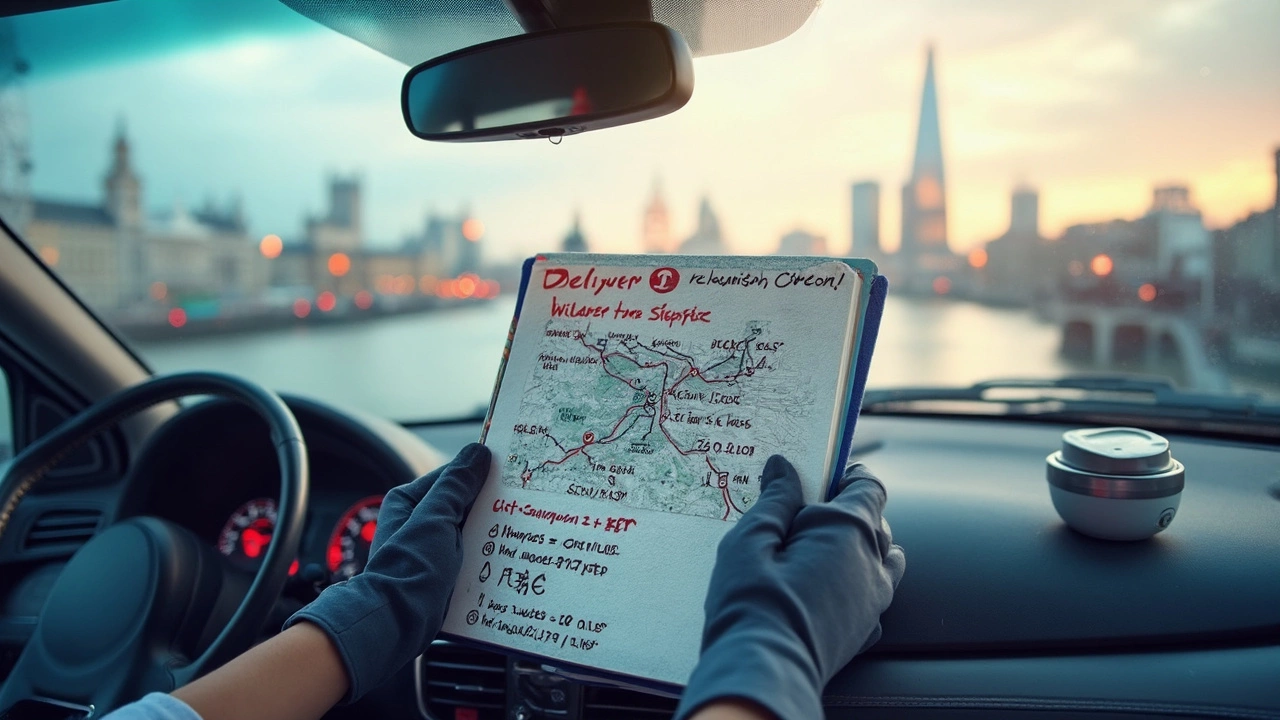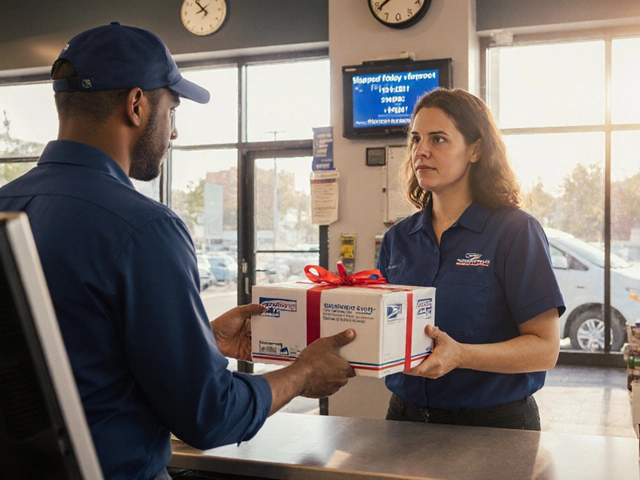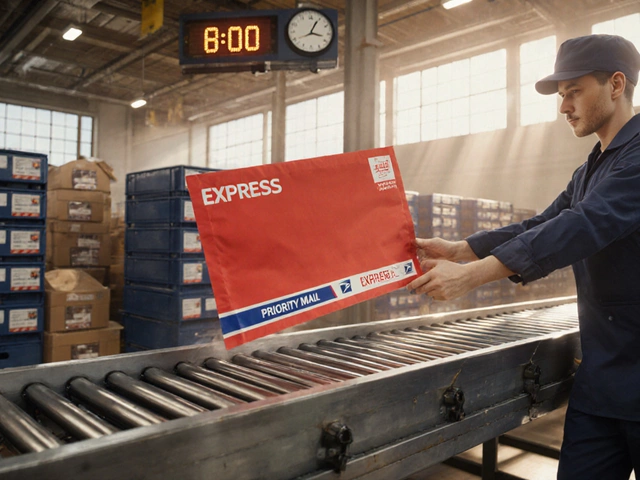If you're looking into courier work, the first thing you'll want to know is how much money you can actually make for every mile you drive. This number—your pay per mile—is a big deal. It drives how much ends up in your pocket at the end of the week.
Pay per mile isn't set in stone across the board. Most couriers see rates that, as of early 2025, average between 40 and 80 cents per mile. Some places pay as little as 35 cents, while others go past a dollar—especially if you're hauling urgent or oversized stuff. Local runs usually bring lower rates than long-haul jobs across states.
Certain companies have flat rates, while others flex with fuel prices, your experience, or how reliable you are with deliveries. Gig app drivers (think Uber Eats or DoorDash) have their own rules and rates. It's not just a number slapped on your paperwork—it’s shaped by location, demand, vehicle type, and your negotiation skills.
If you’re debating whether to take a courier gig, don't just look at the mileage rate. Factor in fuel, maintenance, insurance, and deadhead miles (those unpaid return trips home—that one stings). Knowing these basics helps you size up the offers and avoid common rookie mistakes. Ready to get into the nitty-gritty? Let’s break down how this all shakes out on the road.
- How Is Standard Pay Per Mile Calculated?
- What Affects Your Per-Mile Rate?
- Big Courier Companies and Their Pay Structures
- Making the Most Out of Each Mile
How Is Standard Pay Per Mile Calculated?
Ever wonder where that pay per mile number comes from when you're checking courier jobs? It's not pulled out of thin air—it’s actually a careful mix of a few basic things that make sure couriers get a fair shake and companies stay profitable.
Most companies start with the distance from pickup to delivery. But it isn’t always that straightforward. Here’s how they usually crunch the numbers:
- Distance: This one is obvious. The main pay is based on how many miles you drive between the pickup and drop-off points. GPS or mapping software usually decides this for gig apps and national services.
- Base Rate: Many companies set a base rate, let’s say 50 cents per mile for short runs, that goes up for longer hauls or tougher routes. Some local courier services might stick to the same base rate, while national brands (like FedEx or UPS) have sliding scales.
- Type of items: Are you carrying legal documents or hauling a fridge? Bulky or heavy deliveries often get a bump in per-mile pay.
- Speed or urgency: The faster they need it, the more you might earn. Rush deliveries, especially same-day or overnight, can pay up to 25% more per mile than standard runs.
- Zone or area: Some companies pay more for deliveries in high-traffic urban areas or for jobs that cross out of a ‘home zone’ into a rural stretch.
Here’s a peek at real numbers from 2024, showing how courier services usually set payment:
| Service | Base Pay Per Mile | Rush/Heavy Pay Per Mile |
|---|---|---|
| Local Courier (urban) | $0.45 – $0.60 | $0.70 – $1.00 |
| National Brand (UPS/FedEx) | $0.45 – $0.75 | $0.90 – $1.20 |
| Gig Apps (DoorDash, Uber Eats) | $0.35 – $0.60 | $0.50 – $0.85 |
Remember, your total take-home depends not just on miles, but on stuff like stop pay (extra for each delivery), tips, bonuses, and sometimes fuel surcharges. If you’re comparing jobs, always ask if the quoted pay per mile includes those extras or not. It’s easy to get lured in by a big number that doesn’t include things like deadhead miles or wait time.
What Affects Your Per-Mile Rate?
Several things can make your pay per mile go up or down in the courier business. It’s definitely not a “one size fits all” deal. You’ll notice the rate changes even if you work for the same company but under different conditions or areas.
Here are the biggest factors that decide how much you get paid for every mile you drive:
- Location: Drivers in big cities or busy areas usually see higher rates. If you're working in New York or Los Angeles, for example, you might get 70–90 cents per mile, while in smaller towns, it can drop to 40–50 cents.
- Speed and Urgency: Rush delivery pays more. Same-day and express jobs offer a much higher pay per mile compared to standard deliveries.
- Type of Vehicle: Larger vans, box trucks, or vehicles that can carry more or need special licensing often pull in a higher per-mile fee than those using regular cars.
- Type of Goods: Hauling sensitive, oversized, or hazardous cargo pays more—extra training or certifications can bump your rate.
- Experience and Track Record: New drivers earn less. Once you prove you’re reliable and damage-free, companies tend to offer better routes and higher mileage rates.
- Company Policies: Some companies pay flat rates, while others adjust for gas prices or offer bonuses for loyalty or “on-time” streaks.
- Gas Prices: If fuel costs spike, some companies bump the per-mile rate to help drivers cover expenses, but not all do—so ask upfront.
Check out this table for a quick side-by-side comparison of typical per-mile rates by location and job type:
| Area/Job Type | Typical Pay Per Mile (USD) |
|---|---|
| Major Metro (Rush Delivery) | 0.85 - 1.10 |
| Major Metro (Standard) | 0.60 - 0.80 |
| Small Town | 0.40 - 0.65 |
| Long Haul (Interstate) | 0.45 - 0.65 |
| Special Cargo | 0.90 - 1.20 |
If you're driving for an app (like Uber Eats or DoorDash), know that their rates can drop during slow hours or less busy neighborhoods. Some drivers combine multiple platforms to chase higher peak rates, especially during lunch, dinner, or big events.
Your take-home pay isn’t just about a big number per mile. Watch out for long unpaid “deadhead” miles, and don’t forget to factor in all expenses—maintenance, gas, and even the cost of your phone data plan.

Big Courier Companies and Their Pay Structures
When people think about jumping into courier work, a lot of them wonder how the big-name companies actually pay their drivers. Here's a quick look at how some of the popular courier companies structure their pay per mile—and how those numbers might shake out for you.
FedEx Ground has a system where independent contractors usually get paid by the mile. The rates, as of this year, can run between $0.80 and $1.20 per mile for linehaul routes. Local pickup and delivery routes tend to be paid by the day or by package instead, so “standard pay per mile” is mostly for longer hauls. Contractors are on the hook for their own fuel, insurance, and truck upkeep, so make sure you do that math before signing up.
UPS works differently. Company drivers are usually paid hourly, not per mile. Their union contracts are strong, and base pay starts around $23 an hour for new drivers, jumping up with experience. Those hourly rates mean you’re paid sitting in traffic, waiting for a load, or handling packages—not just for rolling down the highway. That said, some independent contractors running freight for UPS might still see mileage-based pay, often in the same $0.70–$1.10 range.
For Amazon Flex, it's more like gig driving. You’re paid by the block (a set of deliveries in a batch), not per mile. Payouts can look like $18–$25 an hour, but your effective pay per mile will depend on how many stops you cover and the route distance. If you’re driving in high-traffic or urban areas, you might notice your effective rate per mile dips, especially after you count in wait time and parking headaches.
On-demand gig apps like DoorDash, Instacart, and Uber Eats pay per delivery, but most folks break it down to dollars per mile to track what they’re really earning. In busy cities, gig drivers report making about $1.50 per mile including tips. But there’s a catch: long “dead miles” between gigs or waiting for the next order can drag that average way down.
| Company | Common Pay Structure | Typical Rate (2025) |
|---|---|---|
| FedEx Ground | Per mile (linehaul) | $0.80–$1.20 per mile |
| UPS (Company Driver) | Hourly | $23–$40 per hour |
| Amazon Flex | Per block | $18–$25 per hour (avg) |
| DoorDash/Uber Eats | Per delivery | ~$1.50 per mile (incl. tips, varies) |
If you’re new, look at more than just that shiny pay per mile number. Compare what you’ll pay out of pocket for things like fuel, maintenance, and downtime. Some companies offer fuel cards, maintenance discounts, or bonuses during peak times, so factor that into your decision.
Making the Most Out of Each Mile
If you’re driving for courier services, squeezing more dollars from every mile isn’t luck—it’s smart habits and knowing what really matters. One survey from 2024 showed up to a 35% gap between the top-earning drivers and those earning the least, mostly because high earners pay close attention to the details others skip.
The first thing is route planning. Apps like Circuit or RoadWarrior don’t just save time—they cut down wasted miles, meaning you get paid for a bigger chunk of your driving. Stack deliveries in the same area when you can, instead of taking one-off jobs that pull you out of a busy zone.
- Make sure your car or van is well maintained. Running on low tire pressure, for example, can suck up to 3% more fuel, and nobody wants that gas bill.
- Track every expense. Even small stuff, like windshield wiper fluid or car washes, eats into your pay per mile. Saving receipts makes tax time way less painful.
- Pay attention to deadhead miles. If you notice a lot of unpaid return trips, try reaching out to local businesses or another delivery platform for a backhaul job. Sometimes a quick call can double your trip’s profitability.
Some drivers I know team up in group chats to swap tips about the highest-paying places at any time of day. One friend saved nearly $60 a week just by buying gas at the right stations using apps like GasBuddy.
| Tip | Potential Weekly Savings ($) |
|---|---|
| Batched deliveries | 25 |
| Optimized route planning | 20 |
| Discounted fuel | 15 |
Always read the fine print on any new platform you join. Some courier jobs pay high on weekdays but drop their pay per mile on weekends, or vice versa. If you have flexibility, adjust your work hours to the highest-paying time slots. The secret isn’t just driving more—it’s driving smarter so every mile actually counts on your paycheck.





